By David Andrews, Senior
Scientist, and Bill Walker, Managing Editor
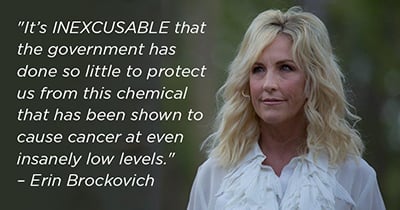
UPDATE: With the release of
EWG's Tap Water Database, we found an additional 32
million Americans who have been supplied water with chromium-6
contamination.
In the film "Erin
Brockovich," the environmental crusader confronts the lawyer of a power
company that polluted the tap water of Hinkley, Calif., with a carcinogenic
chemical called chromium-6. When the lawyer picks up a glass of water,
Brockovich says: “We had that water brought in ‘specially for you folks. Came
from a well in Hinkley.”
The lawyer sets down the glass
and says, "I
think this meeting’s over."
But almost 25 years after that
real-life confrontation,[1]
the conflict over chromium-6 is not over. A new EWG analysis of federal data
from nationwide drinking water tests shows that the compound contaminates water
supplies for more than 200 million Americans in all 50 states. Yet federal
regulations are stalled by a chemical industry challenge that could mean no
national regulation of a chemical state scientists in California and elsewhere
say causes cancer when ingested at even extraordinarily low levels.

The standoff is the latest
round in a tug-of-war between scientists and advocates who want regulations
based strictly on the chemical’s health hazards and industry, political and
economic interests who want more relaxed rules based on the cost and
feasibility of cleanup. If the industry challenge prevails, it will also extend
the Environmental Protection Agency’s record, since the 1996 landmark
amendments to the Safe Drinking Water Act, of failing to use its authority to
set a national tap water safety standard for any previously unregulated
chemical.[2]
In 2008, a two-year study by
the National Toxicology Program found that drinking water with chromium-6, or
hexavalent chromium, caused cancer in laboratory rats and mice.[3]
Based on this and other animal studies, in 2010, scientists at the respected
and influential California Office of Environmental Health Hazard Assessment
concluded that ingestion of tiny amounts of chromium-6 can cause cancer in
people, a conclusion affirmed by state scientists in New Jersey and North
Carolina.
The California scientists set
a so-called public health goal of 0.02 parts per billion in tap water, the
level that would pose negligible risk over a lifetime of consumption.[4]
(A part per billion is about a drop of water in an Olympic-size swimming pool.)
But in 2014, after aggressive lobbying by industry and water utilities, state
regulators adopted a legal limit 500 times the public health goal.[5]
It is the only enforceable drinking water standard at either the state or
federal level.
https://www.youtube.com/watch?v=r6MotXMQUGo
Potentially unsafe
concentrations for two-thirds of Americans
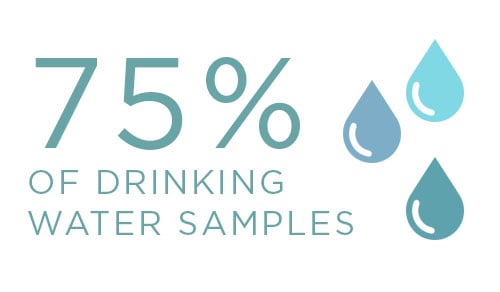
Spurred by a groundbreaking
2010 EWG investigation that found chromium-6 in the tap water of 31 cities[6]
and a Senate hearing prompted by the findings, the EPA ordered local water
utilities to begin the first nationwide tests for the unregulated contaminant.
From 2013 to 2015, utilities took more than 60,000 samples of drinking water
and found chromium-6 in more than 75 percent of them.[7]
EWG's analysis of the test data estimates that water supplies serving 218
million Americans – more than two-thirds of the population – contain more
chromium-6 than the California scientists deemed safe.
Average level of chromium-6 in
U.S. drinking water
https://static.ewg.org/reports/2016/chromium6/EWG_Chrome6_InteractiveMap.jpg
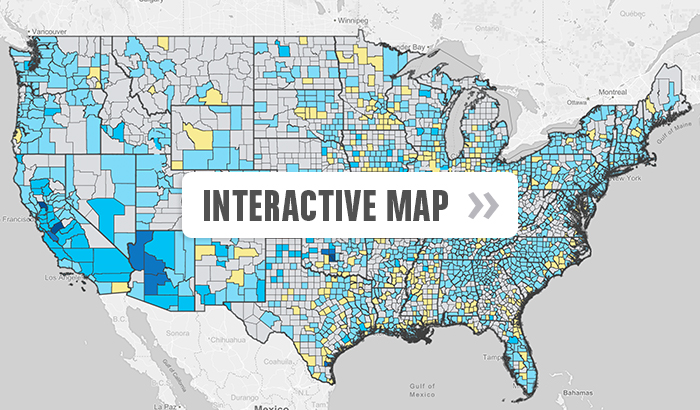
SOURCE: EWG, from EPA Unregulated
Contaminant Monitoring Rule 3 data
The California scientists
based their public health goal of 0.02 parts per billion solely on protecting
people from cancer and other diseases. Public health goals are not legally
enforceable, but legal limits are supposed to be set as close as possible to
health goals “while considering cost and technical feasibility.”[8]
But the California Department of Public Health relied on a flawed analysis that
exaggerated the cost of treatment and undervalued the benefits of stricter
regulation,[9]
and adopted a legally enforceable limit of 10 parts per billion.
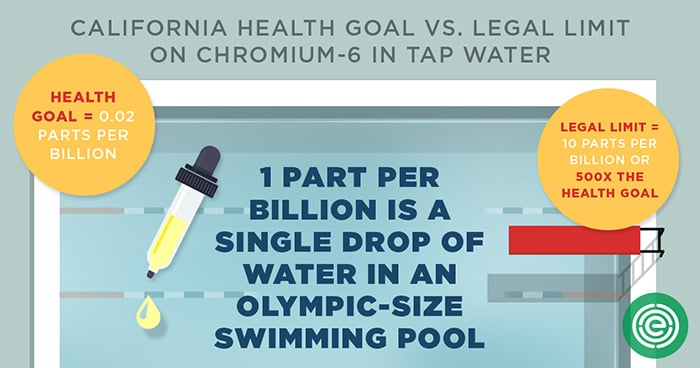
Even by that far-too-lax
benchmark, EWG's analysis of EPA tests shows that more than seven million
Americans are served tap water from supplies that had at least one detection of
chromium-6 higher than the only legal limit in the nation. Because the EPA
tests covered only a fraction of the small systems and private wells that
supply water to more than a third of Americans, it is highly likely that
chromium-6 contamination is even more widespread.[10]
12,000 Americans at risk of
cancer
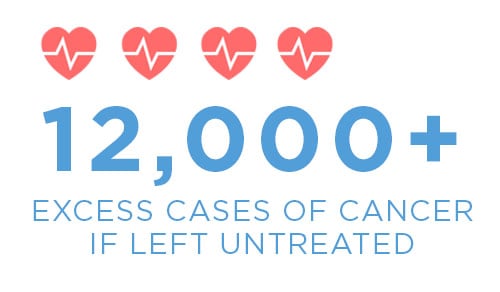
The EPA tests show that water
tested in 1,370 U.S. counties had an average level of chromium-6 exceeding
California's non-binding public health goal – the amount posing no more
than a one-in-a-million risk of cancer for people who drink it daily for 70
years. (By contrast, the state's legal limit represents a cancer risk of 500
per million.) Comparing the public health goal to levels of contamination found
in the EPA tests, EWG estimates that if left untreated, chromium-6 in tap water
will cause more than 12,000 excess cases of cancer by the end of the century.[11]
The tests found chromium-6 in
almost 90 percent of the water systems sampled. Oklahoma, Arizona and
California had the highest average statewide levels and the greatest shares of
detections above California's public health goal. Among major cities, Phoenix
had, by far, the highest average level, at almost 400 times the California
health goal, and St. Louis and Houston also had comparatively high levels.
Average level of chromium-6 in
largest U.S. water systems
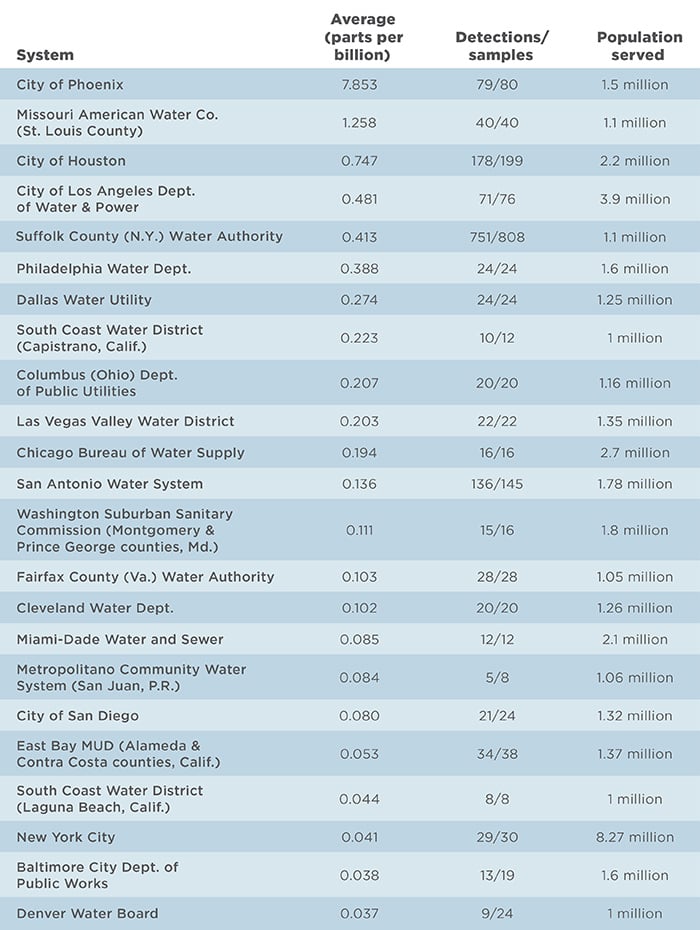
SOURCE: EWG, from EPA Unregulated Contaminant Monitoring Rule 3 data
Battles in New Jersey, North
Carolina
Scientists in California's
Office of Environmental Health Hazard Assessment are not alone in determining
that extraordinarily low levels of chromium-6 in drinking water can cause
cancer.
In 2010, New Jersey's Drinking
Water Quality Institute, a state agency comprised of scientists, utility
officials and citizen experts, calculated a health-based maximum contaminant
level – what California calls a public health goal – of 0.06 parts per
billion, just slightly higher than California's.[12]
This year, scientists in North Carolina's Department of Environmental Quality,
also drawing on the 2008 National Toxicology Program study that drove the
California goal, calculated a do-not-drink level matching the New Jersey
number.[13][14]
But neither New Jersey nor
North Carolina has set a legal limit for chromium-6 in tap water. In both
states, scientists' health-based recommendations were at odds with the
decisions of politically appointed regulators.

In New Jersey, the press
reported the water quality institute's recommendation before it could be
formally submitted to the Department of Environmental Protection for
development of a regulation. According to former DEP planner Bill Wolfe, now an
environmental advocate, this angered Department of Environmental Protection
Commissioner Bob Martin, appointed by Gov. Chris Christie. Wolfe said Martin
not only blocked submission of the recommendation, but effectively stopped the
institute from meeting for four years,[15]
delaying drinking water regulations for more than a dozen chemicals.
In a statement to EWG, a
Department of Environmental Protection spokesman said the department
"vehemently disagrees with the EWG's contention that political pressure in
any way influenced the New Jersey Drinking Water Quality Institute's consideration
of an MCL for chromium-6." The spokesman said EWG's characterization is
based on the "opinion of a single, former NJDEP employee who was last
employed by the agency 12 years ago," and that EWG's criticism is
"critically flawed – and blatantly misleading."
In North Carolina, scientists
at the Department of Environmental Quality were alarmed by levels of chromium-6
in hundreds of private wells near unlined pits where Duke Energy dumped coal
ash. The scientists warned well owners not to drink water with chromium-6
levels higher than their calculations found were safe. But higher-ups at the
department rescinded the do-not-drink warnings, citing the lack of federal
regulation as justification for telling well owners their water met all state
and federal standards.[16]
The head of the Department of
Environmental Quality, Donald R. van der Vaart, previously worked for a utility
that is now part of Duke Energy.[17]
He was appointed by Gov. Pat McCrory, who worked for Duke Energy for 29 years
before he ran for office.[18]
After the McCrory administration issued a public statement attacking the
integrity of a scientist who resisted their plan to rescind the do-not-drink
warnings, state epidemiologist Dr. Megan Davies resigned, saying she “cannot
work for a department and an Administration that deliberately misleads the
public.”[19]
Sources of contamination and
health hazards
The conflict over chromium-6 regulation
stems not only from the question of how much is safe, but the staggering cost
of cleaning up such a widespread contaminant that is an industrial pollutant
but also occurs naturally. The California Department of Public Health estimates
that treating the state's water to meet the legal limit of 10 parts per billion
will cost nearly $20 million a year,[20]
so the cost of meeting the much more stringent public health goal would be far
higher.
There are two main types of
chromium compounds. Chromium-3, or trivalent chromium, is a naturally occurring
compound and an essential human nutrient. Chromium-6 also occurs naturally, but
is manufactured for use in steel making, chrome plating, manufacturing dyes and
pigments, preserving leather and wood and, as in the Brockovich case, lowering
the temperature of water in the cooling towers of electrical power plants.
Chromium-6 is also in the ash from coal-burning power plants, which is
typically dumped in unlined pits that a 2011 report by the nonprofit
Earthjustice said may threaten hundreds or thousands of water supplies and
private wells.[21]
And recent research has suggested that some methods of treating water supplies
to remove other contaminants may actually increase levels of chromium-6.[22]

Human studies by government
and independent scientists worldwide have definitively established that
breathing airborne chromium-6 particles can cause lung cancer, and the U.S.
Occupational Safety and Health Administration sets strict limits for airborne chromium-6
in the workplace. Whether inhaled or ingested, it can also cause liver damage,
reproductive problems and developmental harm.[23]
Studies have found that exposure to chromium-6 may present greater risks to
certain groups, including infants and children, people who take antacids, and
people with poorly functioning livers.[24]
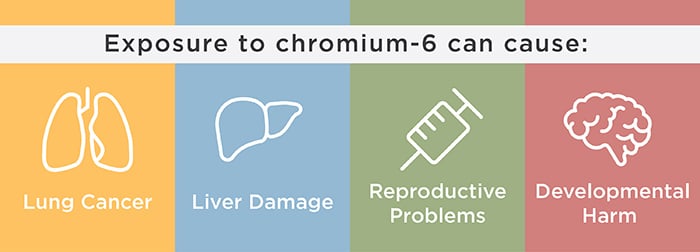
But because of the unsettled
science – including the crucial question of how much chromium-6 the stomach
converts into mostly harmless chromium-3 – the EPA has only set a drinking
water limit for total chromium, the combined level for both compounds. That
outdated regulation from 2001, based on skin rash concerns, is 100 parts per
billion – 5,000 times California's public health goal for chromium-6 and 10
times the state's legal limit.[25]
Industry scheme to discredit
stomach cancer link
After Brockovich uncovered
chromium-6 pollution in Hinkley, residents filed a class-action lawsuit that
Pacific Gas and Electric Company, or PG&E, settled in 1996 for a record $333
million. The case pushed California legislators to pass a law calling for
regulators to set an enforceable drinking water standard. The law set a 2004
deadline for the regulation, but it was delayed by a PG&E-backed scheme.

In 2001, as state scientists
conducted a risk assessment to guide the regulation, an epidemiologist named
Jay Beaumont noticed something fishy. A Chinese scientist had revised a key
study of chromium-6 in drinking water, reversing his original finding of a
strong link to stomach cancer. Some members of a "blue-ribbon" panel
advising the state cited the revised study as evidence against a strong
regulation. But when Beaumont tried to find out why the scientist had changed
his mind, it turned out he was dead.
Beaumont learned that the study
was rewritten not by the original author, but by consultants hired by PG&E
to help defend the Brockovich case. Before the Chinese scientist died, they
paid him a token amount[26]
for access to his original data, manipulated it to hide the link to stomach
cancer, and published the revised study in a scientific journal without
disclosing their or PG&E's involvement.

What's more, the advisory
panel included the head of the consulting firm, Dennis Paustenbach of San
Francisco-based ChemRisk, who was once described in a Newark Star-Ledger
investigation of his role in weakening New Jersey chromium regulations as
having “rarely met a chemical he didn’t like.”[27]
A 2013 investigation by the nonprofit Center for Public Integrity found that
Paustenbach and other ChemRisk employees also worked for General Electric,
Lockheed Martin and Merck, all companies with liability for chromium pollution,
and the Chrome Coalition, an industry lobbying group.[28]
After his role in tampering
with the Chinese study was exposed, Paustenbach resigned from the advisory
panel. Beaumont and his colleagues started over, using the authentic study to
guide the public health goal. In 2005, EWG obtained and published documents and
emails that detailed the deception,[29]
which was also recounted in a front-page story in The Wall Street Journal.[30]
The scientific journal that published the bogus study retracted it.[31]
EWG conducts first-ever tests
for chromium-6 in U.S. cities
In 2010, in the first-ever
tests for chromium-6 in U.S. tap water, EWG found the chemical in 31 of 35
cities, with water in 25 cities containing levels above the California public
health goal.[32]
The worst contamination was in Norman, Okla., where the level was 600 times the
public health goal. Levels in Honolulu, Hawaii; Riverside and San Jose, Calif.;
Madison, Wis.; and Tallahassee, Fla., ranged from 100 to 62 times the
California health goal. Sources of the contamination are largely unknown,
although Oklahoma and California have high levels of naturally occurring
chromium[33]
and California has the nation’s highest concentration of industrial sites that
use chromium.[34]
EWG’s tests and a petition
from environmental groups pushed the EPA to add chromium-6 to the chemicals for
which local utilities must test under the Unregulated Contaminant Monitoring
Rule. The 1996 amendments to the Safe Drinking Water Act require the EPA to
select up to 30 previously unregulated contaminants for testing every five
years. In 20 years, the agency has ordered testing for 81 contaminants, but has
moved forward on setting a regulation for just one, the rocket fuel ingredient
perchlorate, and is two years behind schedule on finalizing and implementing
the regulation.[35][36]
For our analysis, EWG matched
the Unregulated Contaminant Monitoring Rule database with the federal Safe
Drinking Water Information System to obtain county and population data.[37]
Population calculations for each utility were based on EPA data, and when
projected to the county or state level, EWG used the U.S. Census Bureau
estimates from July 2014.[38]
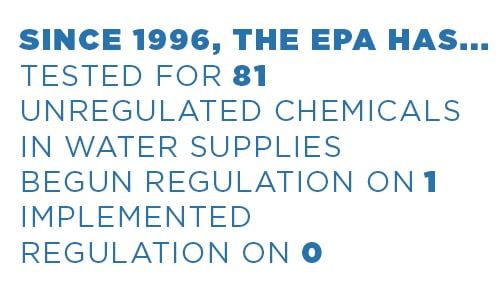
The EPA results match EWG’s
2010 tests closely, with exceptions such as Phoenix and Scottsdale, Ariz., and
Albuquerque, N.M., where the EPA tests detected significantly higher levels of
chromium-6. The EPA results identify several communities where levels of
chromium-6 are strikingly higher than those in the surrounding state, but
determining whether this is because of industrial pollution or natural
occurrences would require site-by-site investigation.
Industry stalls EPA risk
assessment
After the 2008 National
Toxicology Program study found that mice and rats who drank chromium-6-laced
water developed stomach and intestinal tumors, scientists in the EPA's
Integrated Risk and Information System, or IRIS, began a risk assessment, the
first step toward drafting a national regulation to cap chromium-6
contamination in drinking water. They saw that the 2008 study provided clear
evidence that chromium-6 is carcinogenic,[39]
and reviewed hundreds of other studies. In 2010, the EPA completed, but did not
officially release, a draft risk assessment that classified oral exposure to
chromium-6 as “likely to be carcinogenic to humans.”[40]
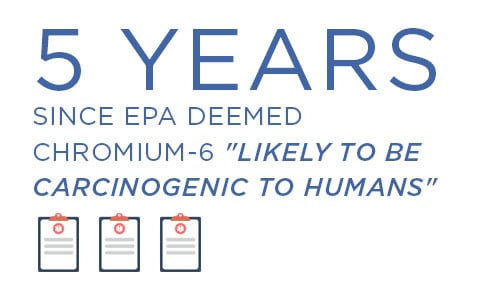
The American Chemistry
Council, the chemical industry's powerful lobbying arm, argued that before
formally releasing the draft for public comment, the EPA should wait for the
publication of studies funded by the Council and the Electric Power Research
Institute on the biological mechanisms through which chromium-6 triggers
cancer. In an April 2011 letter obtained by the Center for Public Integrity,
Vincent Cogliano, acting director of IRIS, responded to the chemistry lobby
that "granting your request could entail a delay of unknown duration with
no public discussion or review of the strong new studies that are now
available."[41]
That's exactly what happened.
An external review panel,
which the Center for Public Integrity later found included three members who
consulted for PG&E in the Brockovich case, pressured the EPA to grant the
American Chemistry Council's request. In 2012, the EPA quietly announced that
the draft risk assessment will be held up until the chemical lobby's studies
are finished. EWG and other public health groups objected vociferously, not
only due to the delay on chromium-6 but "the dangerous precedent suggested
by delaying risk assessment activities to allow incorporation of as-yet
unpublished, industry-funded research."[42]
The EPA's prediction of when
the risk assessment will be released for public comment has been pushed back
repeatedly – from 2015 to the second quarter of 2016, and then to early 2017.[43]
When asked for an update, Cogliano wrote in an Aug. 24 email to EWG: "We
expect to release a draft health assessment document in 2017, though I
wouldn't use the word 'early.'"[44]
EPA may choose to do nothing
Also on Aug. 24, an EPA
spokesperson wrote in an email to EWG that the agency "has not made any
decision regarding revising the drinking water regulations for [total] chromium
or establishing regulations for hexavalent chromium."[45]
That's troubling, as the industry studies are expected to support the position
that the EPA should do nothing at all.
The industry-funded studies
are being conducted by ToxStrategies, a Texas-based science-for-hire consulting
firm. The Center for Public Integrity found that a principal scientist at
ToxStrategies, Mark Harris, had worked on the PG&E-funded scheme to revise
the Chinese scientist's paper linking chromium-6 to stomach cancer while at
ChemRisk. The Center reported that Harris and his ToxStrategies colleague
Deborah Proctor previously "were leaders in the chrome industry's efforts
to dissuade the Occupational Safety and Health Administration from setting
stricter rules for airborne chromium in the workplace."[46]
In June, the Texas Commission
on Environmental Quality released a proposal for a daily safe dose of
chromium-6 in drinking water that drew heavily on studies by Proctor and other
ToxStrategies scientists.[47]
It argues that the EPA's current legal limit for total chromium – 100
parts per billion, with no separate limit on chromium-6 – is adequate to
protect public health. Joseph T. Haney Jr., the Texas state toxicologist who
was the lead author of the paper, told the newsletter Inside EPA it was "a
remarkable coincidence" that his calculations yielded a daily safe dose
corresponding exactly to the EPA's current regulation for total chromium.[48]
Haney's paper assumes there is
a threshold for how much of a contaminant is harmful, and that no level of
chromium-6 the EPA tests found in U.S. drinking water exceeded that amount. But
the so-called linear method the EPA generally requires for mutagens –
carcinogenic chemicals that cause cancer by damaging DNA, which can occur when
even a single molecule enters a cell – assumes that any level of exposure
carries some risk. The National Toxicology Program's 2008 two-year study of lab
animals found clear evidence that chromium-6 causes cancer, and the EPA's 2010
draft risk assessment found that it is a powerful mutagen, so the linear method
should be used to calculate cancer risk.[49]
The ToxStrategies model
rejects the EPA's finding that chromium-6 causes cancer by damaging DNA,
instead arguing that it causes hyperplasia, an increase in the number of cells,
which may or may not be cancerous. It is based on a 90-day animal exposure
study, in contrast to the more rigorous two-year National Toxicology Program study.
It also ignores the growing body of independent research exploring the effects
of small doses of carcinogens in combination with the myriad other
cancer-causing chemicals Americans are exposed to daily.[50]
A dangerous precedent
If the EPA accepts the
ToxStrategies threshold model, it could mean not only that chromium-6 will
remain unregulated in drinking water, but also set a precedent that could
undermine health protections for other carcinogenic chemicals. The EPA must
reject the industry-backed effort, which is supported not by unbiased science
to protect health, but by agenda-driven research to protect polluters from
paying cleanup costs.
The recent conflict in North
Carolina is one example of how the EPA's failure to set enforceable national
regulations is leaving Americans at risk from chromium-6 contamination. The
result is not just an unsettled scientific debate, but the exposure of hundreds
of millions of people to a cancer-causing chemical in their drinking water.

Cleaning up water supplies
contaminated with chromium-6 will not be cheap. But the answer to high costs is
not allowing exposures at unsafe levels while pretending water is safe. And the
fact that some unknown level of chromium-6 contamination comes from natural
sources does not negate Americans’ need to be protected from a known
carcinogen.
Instead, the EPA and state
regulators must set drinking water standards to protect the public, including
those more susceptible to the toxic effects of chromium-6. Chromium-6 polluters
must be held accountable and pay their shares of cleanup costs. The EPA and
state regulators must focus on ensuring that water systems lacking the
resources to meet health-protective standards have access to necessary funding,
expertise and support so they can provide communities with truly safe water.
Are you outraged? Us too. Take
action today!
Are you ready to take the next
step? Join EWG and tell the EPA it’s time to take action on chromium-6
contamination in drinking water. Enter your information below and we’ll add
your name to EWG’s petition to the EPA urging it to set a national safety limit
for chromium-6 in drinking water.
Top of Form
Bottom of Form
Top of Form
see petition online at:
http://www.ewg.org/research/chromium-six-found-in-us-tap-water#.WZjV_Om1u1sBottom
of Form
This report has been updated
to include a response from the New Jersey Department of Environmental
Protection to allegations that political interference blocked development of a
chromium-6 drinking water standard.
1 In the film the exchange
takes place in a law firm’s conference room, but it was actually in a
courtroom.
2 U.S. Government
Accountability Office, Safe Drinking Water Act. EPA Should Improve
Implementation of Requirements on Whether to Regulate Additional Contaminants.
May 2011. Available at www.gao.gov/assets/320/318967.pdf
3 National Toxicology Program,
Technical Report on the Toxicology and Carcinogenesis Studies of Sodium Dichromate
Dihydrate (CAS No. 7789-12-0) in F344/N Rats and B6C3F1 Mice (Drinking Water
Studies). Available at https://ntp.niehs.nih.gov/ntp/htdocs/lt_rpts/tr546.pdf
4 California Office of
Environmental Health Hazard Assessment, Final Technical Support Document on
Public Health Goal for Hexavalent Chromium In Drinking Water. July 29, 2011.
Available at www.oehha.ca.gov/water/phg/072911Cr6PHG.html
5 California EPA, Chromium-6
Drinking Water MCL. Available at
www.waterboards.ca.gov/drinking_water/certlic/drinkingwater/Chromium6.shtml
6 EWG, Chromium-6 in U.S. Tap
Water. Dec. 20, 2010. Available at www.ewg.org/research/chromium6-in-tap-water
7 U.S. EPA, Occurrence Data
for the Unregulated Contaminant Monitoring Rule. April 2016. Available at
www.epa.gov/dwucmr/occurrence-data-unregulated-contaminant-monitoring-rule#3
8 California Department of
Public Health, Hexavalent Chromium MCL Initial Statement of Reasons. Aug. 4,
2013. Available at
www.cdph.ca.gov/services/DPOPP/regs/Documents/DPH-11-005HCMCLISOR.pdf
9 EWG et al., Letter to
Michael McKibben, California Department of Public Health, Re: CDPH-11005
(Hexavalent Chromium). Oct. 11, 2013. Available at
https://static.ewg.org/pdf/Hex-Chrome-Joint-Comments-10-11-13jc.pdf
10 U.S. EPA, Drinking Water
and Ground Water Statistics, Fiscal Year 2011. Available at
www.epa.gov/waterdata/drinking-water-tools
11 Excess cancers were
calculated by dividing the average chromium-6 level in each state by the
California public health goal of 0.02 ppb, which the state's Office of
Environmental Health Hazard Assessment said represents a one-in-a-million risk
of cancer if consumed daily for 70 years. This value was then multiplied by the
state's 2014 population according to the Census Bureau, then linearly scaled to
the 84 years until the end of the 21st century. These estimates assume an equal
distribution of chromium-6 across each state, that all residents consume two
liters of unfiltered water daily and that the population and hexavalent
chromium levels will remain constant until the year 2100.
12 New Jersey Drinking Water
Quality Institute, Sept. 10, 2010 Meeting Minutes. Available at
www.nj.gov/dep/watersupply/pdf/minutes100910.pdf
13 Mollie Young, North
Carolina Department of Environmental Quality, Memorandum to Environmental
Review Commission and Joint Legislative Oversight Committee. April 1, 2016.
Available at
www.ncleg.net/documentsites/committees/ERC/ERC%20Reports%20Received/2016/Department%20of%20Environmental%20Quality/2016-April%20Study%20of%20Cr(VI)%20and%20V%20Stds.pdf
14 In their initial draft,
California scientists set a public health goal of 0.06 parts per billion, the
same number later calculated by scientists in New Jersey and North Carolina,
but after reviewing more studies lowered it to 0.02 parts per billion.
15 Personal communication to
EWG from Bill Wolfe, former policy analyst for the New Jersey Department of
Environmental Protection, Aug. 25, 2016. Wolfe spoke at the news conference to
announce the Drinking Water Quality Institute's health-based maximum contaminant
level for chromium-6 in drinking water.
16 Craig Jarvis, Chief
Epidemiologist Resigns as Fight Over Well Water Safety Escalates. The News
& Observer, Aug. 10, 2016. Available at
www.newsobserver.com/news/politics-government/politics-columns-blogs/under-the-dome/article94769757.html
17 John Murawski, NC’s New
Environmental Regulator is Polarizing Figure. The News & Observer, Oct. 31,
2015. Available at www.newsobserver.com/news/business/article42125817.html
18 Richard M. Barron, Breaking
Silence, McCrory Discussed Career with Duke. (Greensboro, N.C.) News &
Record March 2, 2014. Available at
www.godanriver.com/news/coal-ash/breaking-silence-mccrory-discusses-career-with-duke/article_8d86b81e-a1ac-11e3-abca-001a4bcf6878.html
19 Letter from Dr. Megan
Davies to Richard Brajer, Secretary of the North Carolina Department of Health
and Human Services, Aug. 10, 2016. Available through WNCN-TV at
https://mgtvwncn.files.wordpress.com/2016/08/daviesresignationpdf10aug2016.pdf
20 Michael S. Feely and John
A. Heintz, Calif. to Make Waves with New Drinking Water Standard. Law360, Feb.
28, 2014. Available at
www.law360.com/articles/508031/calif-to-make-waves-with-new-drinking-water-standard
21 Earthjustice, Physicians
for Social Responsibility and the Environmental Integrity Project, EPA’s Blind
Spot: Hexavalent Chromium in Coal Ash. Feb. 1, 2011. Available at
www.earthjustice.org/sites/default/files/CoalAshChromeReport.pdf
22 Michelle Chebeir and
Haizhou Liu, Kinetics and Mechanisms of Cr(VI) Formation via the Oxidation of
Cr(III) Solid Phases by Chlorine in Drinking Water. Environmental Science &
Technology, January 2016. Available at
pubs.acs.org/doi/abs/10.1021/acs.est.5b05739. Also: Dana R. Lindsay et al.,
Oxidation of Cr(III) to Cr(VI) during chlorination of drinking water. Journal
of Environmental Monitoring, March 2012. Available at
pubs.rsc.org/en/Content/ArticleLanding/2012/EM/c2em00012a
23 U.S. EPA, Chromium
Compounds Hazard Summary. Revised January 2000, accessed August 2016. Available
at www3.epa.gov/airtoxics/hlthef/chromium.html
24 California Office of
Environmental Health Hazard Assessment, Final Technical Support Document On
Public Health Goal for Hexavalent Chromium In Drinking Water. July 29, 2011.
Available at www.oehha.ca.gov/water/phg/072911Cr6PHG.html
25 California Office of
Environmental Health Hazard Assessment, Final Technical Support Document On
Public Health Goal for Hexavalent Chromium In Drinking Water. July 29, 2011.
Available at www.oehha.ca.gov/water/phg/072911Cr6PHG.html
26 Testimony in a trial of
PG&E for chromium-6 pollution in other California communities indicates the
amount was $1,960.
27 Alexander Lane, When
Corporations Need an Expert, He Gladly Answers the Call. Newark Star-Ledger,
March 7, 2004. Republished at www.precaution.org/lib/06/scientist_for_hire.20040308.htm
28 David Heath, How Industry
Scientists Stalled Action on Carcinogen. The Center for Public Integrity, March
13, 2013. Available at
www.publicintegrity.org/2013/03/13/12290/how-industry-scientists-stalled-action-carcinogen
29 EWG, Chrome-Plated Fraud:
How Scientists-For-Hire Reversed Findings of Cancer Study. Dec. 23, 2005.
Available at www.ewg.org/research/chrome-plated-fraud
30 Peter Waldman, Study Tied
Pollutant to Cancer; Then Consultants Got Hold of It. Wall Street Journal, Dec.
23, 2005. Available at www.wsj.com/articles/SB113530126572230084
31 Paul Brandt-Rauf, Editorial
Retraction. Journal of Occupational and Environmental Medicine, July 2006.
Available at journals.lww.com/joem/Citation/2006/07000/Editorial_Retraction.19.aspx
32 EWG, Chromium-6 in U.S. Tap
Water. Dec. 20, 2010. Available at www.ewg.org/research/chromium6-in-tap-water
33 U.S. Geological Survey,
Geochemical Landscapes of the Conterminous United States – New Map
Presentations for 22 Elements, 2001. Available at pubs.usgs.gov/pp/p1648/
34 U.S. Bureau of Mines,
Chromium Life Cycle Study. May 3, 1995. Available at
pubs.usgs.gov/usbmic/ic-9411/ic-9411.pdf
35 U.S. EPA, Monitoring the
Occurrence of Unregulated Drinking Water Contaminants. Available at
www.epa.gov/dwucmr
36 William Gorta, EPA Owns Up
to Blowing Deadline to Limit Perchlorate. Law 360, Aug. 31, 2016. Available at
www.law360.com/articles/835111/epa-owns-up-to-blowing-deadline-to-limit-perchlorate
37 U.S. EPA, Chromium in
Drinking Water. Accessed June 2015. Available at
water.epa.gov/drink/info/chromium/#one
38 U.S. Census Bureau, 2014
Population Estimates. Accessed August 2016. Available at
www.census.gov/popest/data/index.html
39 National Toxicology
Program, Technical Report on the Toxicology and Carcinogenesis Studies of
Sodium Dichromate Dihydrate (CAS No. 7789-12-0) in F344/N Rats and B6C3F1 Mice
(Drinking Water Studies). Available at
https://ntp.niehs.nih.gov/ntp/htdocs/lt_rpts/tr546.pdf
40 U.S. EPA, Statement from
Administrator Jackson Regarding Her Meeting with 10 U.S. Senators on
Chromium-6. Dec. 22, 2010. Available at
yosemite.epa.gov/opa/admpress.nsf/d0cf6618525a9efb85257359003fb69d/5876c7ed5950679385257801006be6bc!OpenDocument
41 Letter from Vincent
Cogliano, EPA Integrated Risk information System, to Ann Mason, American
Chemistry Council, April 7, 2011. Available through the Center for Public
Integrity at
www.documentcloud.org/documents/551115-vincent-cogliano-to-acc.html
42 EWG, Letter to Vincent
Cogliano, EPA Integrated Risk Information System, Aug. 30, 2011. Available at
http://static.ewg.org/pdf/EWG-IRIS-Cr6.pdf
43 Maria Hegstad, Texas
Approach to Cr6 May Increase Pressure For EPA to Use Industry Data. Inside EPA,
July 14, 2016. Available at insideepa.com/daily-news/texas-approach-cr6-may-increase-pressure-epa-use-industry-data
44 Email from Cogliano, Aug.
24, 2016.
45 Email from Enesta Jones,
EPA Office of Media Relations, Aug. 24, 2016.
46 David Heath, How Industry
Scientists Stalled Action on Carcinogen. The Center for Public Integrity, March
13, 2013. Available at
www.publicintegrity.org/2013/03/13/12290/how-industry-scientists-stalled-action-carcinogen
47 Texas Commission on
Environmental Quality, Proposed Development Support Document, Hexavalent Chromium
Oral Reference Dose. June 2016. Available at
www.tceq.com/assets/public/implementation/tox/dsd/proposed/june2016/hexchromoral.pdf
48 Maria Hegstad, Inside EPA,
op. cit.
49 Nancy McCarroll et al., An
Evaluation of the Mode of Action Framework for Mutagenic Carcinogens Case Study
II: chromium (VI). Environmental and Molecular Mutagenisis, March 2010.
Available at www.ncbi.nlm.nih.gov/pubmed/19708067. Also: Anatoly Zhitkovich,
Chromium in Drinking Water: Sources, Metabolism, and Cancer Risks. Chemical
Research in Toxicology, October 2011. Available at
www.ncbi.nlm.nih.gov/pubmed/21766833
50 Getting to Know Cancer,
Assessing the Carcinogenic Potential of Low Dose Exposures to Chemical Mixtures
in the Environment. Accessed August 2016. Available at www.gettingtoknowcancer.org/taskforce_environment.php
No comments:
Post a Comment